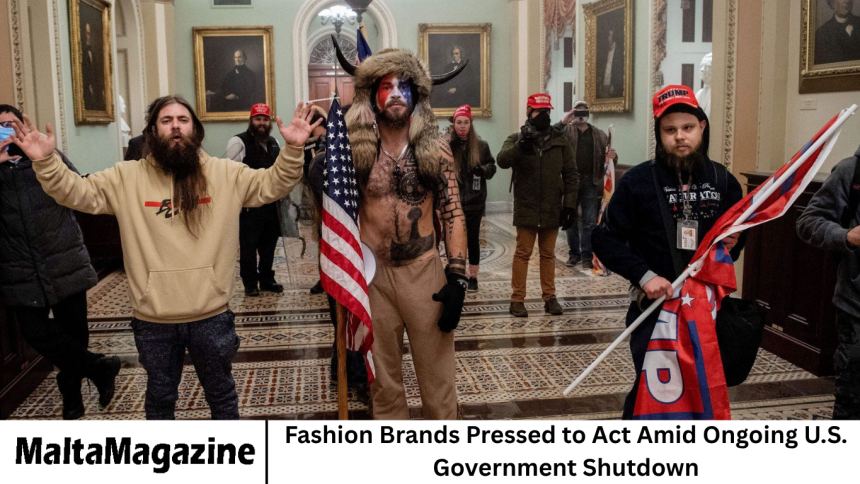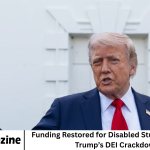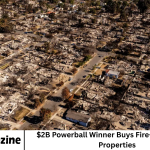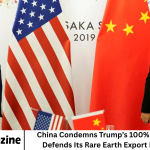The ongoing U.S. government shutdown has begun to ripple across multiple industries, and the fashion sector—often thought to be insulated from political turmoil—is now feeling the strain. As the shutdown stretches into weeks, fashion brands, retailers.
- A Growing Economic Ripple Effect
- Fashion’s Dependence on Federal Agencies
- Consumer Confidence Takes a Hit
- The Supply Chain Squeeze
- Calls for Industry Solidarity and Action
- Labor Concerns and Worker Welfare
- Political Stalemate and Business Anxiety
- Digital Adaptation as a Lifeline
- Sustainability Efforts Face Temporary Setbacks
- Global Impact and International Reactions
- Consumers React with Pragmatism
- A Test of Leadership and Resilience
- The Road Ahead
- Frequently Asked Question
- Conclusion
And manufacturers are being urged to take proactive steps to mitigate economic losses, protect their workers, and maintain supply chain stability. The crisis is testing the adaptability of an industry already dealing with inflation, disrupted global logistics, and shifting consumer priorities.
For many Americans, the phrase “government shutdown” conjures images of closed national parks or unpaid federal workers. But for business owners, manufacturers, and retailers, it means far more than that.
More Read: Funding Restored for Disabled Students Despite Trump’s DEI Crackdown
A Growing Economic Ripple Effect
When a U.S. government shutdown drags on, it doesn’t just mean delayed paychecks for federal workers—it disrupts systems that many industries depend on. The fashion industry, for example, relies on several government functions that have now slowed or stopped entirely.
Customs and border protection operations are running at limited capacity, which means imported textiles, fabrics, and finished apparel are facing delays at ports. Brands that depend on overseas manufacturing, particularly from Asia, are finding their shipments stalled or held up in customs clearance backlogs.
Moreover, permits and certifications that are typically required for importing goods, like textile labeling compliance and safety documentation, have also slowed down. This has led to bottlenecks in distribution and delayed product launches.
Retailers expecting new collections to hit stores in time for holiday sales or seasonal transitions are left uncertain. In financial terms, analysts estimate that even a short-term disruption can cost the U.S. economy billions.
For fashion companies that operate on tight seasonal calendars, a few weeks of delay can mean entire lines missing their optimal market window.
Fashion’s Dependence on Federal Agencies
The U.S. fashion sector is deeply intertwined with several federal agencies, whether through trade regulation, environmental oversight, or labor relations. The Department of Commerce and the International Trade Administration play key roles in negotiating trade deals and tariffs.
The Environmental Protection Agency oversees regulations on manufacturing and waste disposal—particularly relevant for textile production and chemical dyes. With many of these agencies partially shuttered or operating under reduced capacity, the fashion ecosystem has become tangled in uncertainty.
For instance, small and medium-sized fashion startups that rely on federal grants, export documentation, or Small Business Administration loans are facing long delays. Emerging designers who were planning to debut collections internationally may have to postpone their launches or scale down marketing efforts.
Without the usual level of administrative support, they are left to navigate complex export and import laws alone.
Consumer Confidence Takes a Hit
Beyond the logistical challenges, the ongoing shutdown has a psychological effect on consumer spending. When people see economic instability—especially when it involves government workers not receiving paychecks—it often leads to reduced consumer confidence.
For fashion retailers, that means fewer people shopping for non-essential items. High-end brands are particularly vulnerable to dips in consumer sentiment, as luxury spending tends to decrease during periods of political or economic uncertainty.
According to several retail trackers, fashion sales during a prolonged shutdown can dip by 5% to 10% nationwide, depending on duration. Brick-and-mortar stores, which are already under pressure from online competition, feel the pinch the most.
Department stores and boutiques in urban areas near government hubs like Washington D.C., New York, and Los Angeles report declining foot traffic as local economies tighten. Even e-commerce sales are not immune.
Consumers who fear delayed paychecks or future instability tend to pull back on discretionary online spending as well. This behavioral shift adds another layer of pressure on fashion brands already dealing with rising costs for materials, logistics, and advertising.
The Supply Chain Squeeze
Fashion supply chains are notoriously complex. A single garment may require fabric from China, zippers from Japan, and assembly in Bangladesh before being shipped to U.S. stores. During a government shutdown, customs slowdowns.
And administrative holdups create choke points at every stage of the process. Delays in customs clearance can cascade into warehouse congestion, shipping rescheduling fees, and missed retail deadlines.
Even domestic production isn’t immune. American factories that rely on imported materials face shortages, while logistics partners—like freight companies—must adjust to irregular shipment schedules.
The shutdown’s ripple effects thus extend far beyond government agencies and reach deeply into private industry operations. Sustainability initiatives, which many fashion brands have been ramping up, are also being affected.
Some of these programs rely on collaboration with federal agencies or on data collected from environmental studies funded by government bodies. With many of those programs paused or underfunded during the shutdown, progress toward greener fashion practices is temporarily hindered.
Calls for Industry Solidarity and Action
In the midst of this disruption, industry leaders and trade organizations are calling on fashion brands to take collective action. The Council of Fashion Designers of America (CFDA), along with several retail advocacy groups, has urged companies to strengthen domestic collaboration.
And find temporary solutions for disrupted trade routes. Some large brands are using their influence to pressure policymakers to resolve the political deadlock, emphasizing that prolonged shutdowns harm not only federal employees.
But also the millions of private-sector workers who depend on stable trade and consumer spending. Others are pivoting toward creative solutions. A few apparel manufacturers are shifting temporarily to domestic suppliers to avoid customs delays.
Retailers are also reworking marketing campaigns to focus on timeless, season-neutral products rather than time-sensitive collections. By adjusting their messaging, brands hope to maintain relevance even as supply issues linger.
Smaller brands, meanwhile, are forming cooperative alliances to share shipping costs, storage spaces, and marketing channels. This kind of collaboration—rare in a highly competitive industry—reflects a growing sense of solidarity among businesses trying to weather the storm.
Labor Concerns and Worker Welfare
Another pressing concern is the welfare of fashion industry workers. Many production facilities and distribution centers employ part-time or contract workers who can be quickly affected by reduced operations. When shipments stall and production slows, these workers often face reduced hours or layoffs.
Fashion unions and labor advocacy groups have called on major brands to protect their workers during the shutdown. This includes offering flexible scheduling, wage protection programs, or temporary remote assignments for design and administrative teams.
Ethical sourcing and labor transparency—issues that have gained prominence in recent years—are now being tested under the weight of real-world economic strain. Consumers, too, are paying closer attention to how brands respond.
In an era where social responsibility drives consumer loyalty, companies that demonstrate compassion and responsibility toward their employees are likely to earn long-term goodwill.
Political Stalemate and Business Anxiety
The longer the shutdown lasts, the greater the anxiety among fashion executives. Political uncertainty creates an unpredictable business environment, making it difficult for companies to plan for upcoming quarters.
Marketing budgets, new collection launches, and retail expansions are all tied to forecasts that depend on economic stability. Some analysts warn that if the shutdown continues, the U.S. fashion industry could face lasting consequences, including loss of investor confidence and reduced international competitiveness.
Foreign fashion houses may gain an edge as American brands struggle with logistical challenges and delayed releases. At the same time, the crisis highlights how deeply fashion is connected to broader political and economic systems.
It underscores the fact that even creative industries cannot thrive in isolation from government stability.
Digital Adaptation as a Lifeline
For many brands, digital transformation has become a vital survival strategy. During economic uncertainty, e-commerce platforms offer a relatively stable channel for reaching consumers. Fashion houses that invested early in online retail, direct-to-consumer (DTC) sales.
And social media marketing are better positioned to maintain sales despite external disruptions. Some companies are turning to virtual fashion shows, online pre-orders, and digital collections to reduce dependency on physical logistics.
By minimizing inventory and emphasizing made-to-order systems, brands can reduce waste and financial risk. Furthermore, artificial intelligence and data analytics tools are helping brands forecast demand more accurately in uncertain times.
By analyzing online behavior and social trends, companies can adjust production levels in real time, avoiding the costly overstocking mistakes that plagued the industry during previous crises.
Sustainability Efforts Face Temporary Setbacks
In recent years, fashion brands have made visible strides toward sustainability, transparency, and ethical production. However, the government shutdown has disrupted progress in several ways. Many sustainability programs rely on federal partnerships or grant funding.
Such as recycling initiatives and pollution control projects. With these programs halted, brands may struggle to meet environmental commitments in the short term. Additionally, public reporting requirements for sustainability.
Such as emissions tracking or waste management—may face delays due to unavailable data from federal environmental agencies. This affects not only compliance but also the credibility of sustainability reporting to investors and consumers.
Despite the setbacks, some companies are taking independent measures to stay on track. They are partnering with private organizations, non-profits, and universities to continue environmental research and innovation.
This independence could mark a turning point for fashion’s sustainability journey—shifting from reliance on government structures to self-regulated industry initiatives.
Global Impact and International Reactions
The U.S. shutdown’s impact isn’t confined within national borders. Many international partners—particularly in Asia and Europe—depend on American trade activity to maintain their fashion export markets. Delays in customs, shipping, and payments are causing ripple effects across the global supply chain.
Foreign suppliers are expressing concern about the reliability of American buyers during periods of political instability. This perception could lead to higher prices or stricter payment terms in future contracts, further straining U.S. fashion companies.
Global fashion councils and export agencies are monitoring the situation closely. Some are offering alternative shipping channels or credit options to mitigate disruptions. International fashion weeks may also see reduced American participation if brands remain uncertain about production schedules and travel budgets.
Consumers React with Pragmatism
Interestingly, while overall spending may decline, some consumer behaviors are shifting in constructive ways. During uncertain times, shoppers tend to prioritize value, quality, and durability. This could benefit brands that promote sustainable fashion and timeless design over fast fashion and disposable trends.
A growing number of consumers are also turning to secondhand shopping, clothing rental services, and DIY upcycling. These behaviors, while driven by economic caution, align with long-term sustainability goals.
If brands can adapt to these preferences, they may emerge from the shutdown with stronger consumer loyalty. Some experts suggest that the crisis could accelerate a cultural shift away from overconsumption and toward more mindful fashion choices.
Brands that emphasize authenticity, transparency, and connection with consumers may thrive even in adversity.
A Test of Leadership and Resilience
As the shutdown continues, the fashion industry stands at a crossroads. The crisis has exposed vulnerabilities but also opportunities for innovation and collaboration. It has prompted executives to rethink strategies, reinforce supply chain resilience, and reaffirm commitments to ethical practices.
Strong leadership is essential during such times. Companies that maintain clear communication with employees, partners, and customers will likely navigate the turbulence more successfully.
Transparent updates, proactive planning, and empathy-driven policies can make a significant difference in preserving both brand image and operational stability. In the long run, the lessons learned from this shutdown could reshape how fashion businesses prepare for future crises.
Whether political, economic, or environmental.
The Road Ahead
The future remains uncertain, but the fashion industry’s adaptability has always been one of its defining traits. From the Great Depression to the COVID-19 pandemic, fashion has consistently reinvented itself in the face of adversity.
The ongoing U.S. government shutdown presents another such challenge—one that may ultimately inspire deeper resilience and creativity. If political leaders fail to reach an agreement soon, brands will need to strengthen contingency plans.
This includes diversifying supply chains, increasing digital investment, and engaging in advocacy to ensure the voices of creative industries are heard in national discussions. At the same time, consumers can play a role by supporting ethical, transparent, and responsible fashion choices.
Fashion is not merely about clothes—it is about expression, identity, and culture. For that reason, the industry’s response to this political and economic disruption will speak volumes about its values and its vision for the future.
Frequently Asked Question
How is the U.S. government shutdown affecting the fashion industry?
The shutdown is disrupting customs operations, delaying imports and exports, slowing trade permits, and lowering consumer spending. It affects everything from fabric sourcing to retail sales, making it harder for brands to meet deadlines or launch new collections.
Why are fashion brands being urged to take action?
Because the industry depends on federal systems for trade, labor, and environmental compliance, brands must find independent solutions during the shutdown—such as shifting to domestic suppliers, improving digital sales, and supporting workers to maintain stability.
Are luxury fashion houses affected as much as smaller brands?
Yes, though in different ways. Luxury brands face reduced consumer spending and investor uncertainty, while smaller brands struggle with shipping costs, regulatory delays, and lack of financial flexibility.
What steps can fashion companies take to minimize the impact?
They can diversify their suppliers, prioritize e-commerce channels, collaborate with other businesses, and implement flexible scheduling for workers. They can also use digital forecasting tools to optimize inventory and sales strategies.
Will this shutdown slow sustainability progress in fashion?
Temporarily, yes. Many sustainability programs depend on government funding or partnerships. However, some brands are continuing independently by partnering with private organizations to maintain eco-friendly initiatives.
How are consumers reacting to the shutdown’s impact on fashion?
Consumers are becoming more cautious with spending, choosing quality over quantity. Many are turning to sustainable or secondhand fashion, signaling a shift toward more mindful consumption.
What long-term lessons might the fashion industry learn from this crisis?
The key lessons include the importance of supply chain resilience, digital innovation, ethical labor practices, and strategic adaptability. The industry may emerge stronger, more transparent, and more consumer-focused as a result.
Conclusion
The U.S. government shutdown has become a mirror reflecting fashion’s deep ties to politics, economics, and society. While it poses real challenges, it also invites introspection and reform. Fashion brands that respond with creativity, solidarity.
And responsibility will not only endure but help shape a more sustainable and adaptive future for the entire industry.








